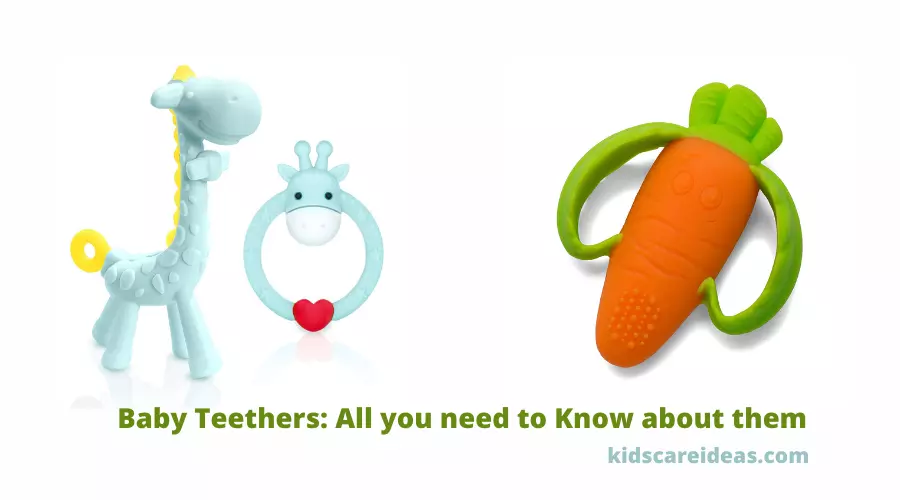Teething is one of the hardest phases of a baby’s life. Teething is the passage of teeth into the mouth area.
It starts after six months of pregnancy. It is caused by the tooth emerging from the gums. Teething is basically the growth of new teeth.
Teethers are a common yet often essential tool that many parents will use to keep their child’s gums from getting sore while they’re teething!
If you want to know about baby Teethers, then here is the complete information like different types of teethers, what they are used for and what the advantages and disadvantages are.
Let’s get started!
What are Teethers?
Baby Teethers are specially made objects for babies to chew on to help relieve the pain of their teething. If your child is teething, it can be quite painful for them. Teethers are specially made for this reason, they are designed to help relieve pain, while also being fun for them to play with.
Your child feels relief while they are playing with it, and it helps them to have some fun while mouthing about something.

When to use Teethers for babies?
Teethers are used to soothe your baby’s mouth pain.
They are typically given to babies when they start teething, but it is also a good idea to have them around as a backup if the child gets their hands on one of the soothers and bites down hard on it.
Most teethers are not intended for children under three months, so limiting their use before then is best.
Type of Teethers
There are three different types of teethers: they include Silicone, rubber, and wood.
These three materials are the most popular because they are all relatively easy to wash, which is vital if your child gets sick and provides an interesting texture for the baby.
1. Silicone Teethers:
Silicone is the most popular material for baby teethers because it’s effortless to clean, even in a dishwasher. Because of this, it’s also the safest option since you can sanitize them between uses.
They are either made from food-grade Silicone. It’s best to check that it is BPA and Phthalate free.
2. Rubber Teethers
Rubber teethers are best for babies who tend to put everything in their mouths since they’re dishwasher-safe and can be sanitized.
They may not be very hygienic because bacteria can develop inside the cracks in the rubber.
3. Wood Teethers
Wood teethers provide a natural texture for your baby to chew on, are easily cleaned in the dishwasher, and usually, last a long time.
Check that it is BPA-free before you buy one.
Wood vs silicone teethers
Both types of teethers have their pros and cons.
Wooden soothers are typically cuter than silicone ones, but silicone ones tend to be of higher quality.
Silicone is also easier to clean up after than wooden ones since you can throw them into the dishwasher when you want to give it a good scrub down.
Baby Teether Use
Tethers are used to soothe pain in the baby’s mouth.
Parents typically recommend putting one of these on their child’s teething toy before giving it back to the baby after it has been washed since this is when your child will be at its most upset about not having something in their mouth.
Teether for babies Advantages and Disadvantages
Advantages
- Teethers are used to soothe pain in the baby’s mouth.
- They come in many different shapes, sizes, and materials.
- Many babies prefer them over regular teething toys because they can use them similarly to how they usually use their hands.
Disadvantages
- They typically cannot be washed in the dishwasher.
- Sometimes, babies can use them like toys instead of teethers if they aren’t holding them correctly.
- This is especially true with wooden ones since their stronger texture makes them harder to chew on than the other teethers.
How to choose baby teethers
There are several precautions that you must take when buying a teether.
The teether material is an essential consideration since some materials are porous, which means they can harbor bacteria and lead to oral health problems for your baby.
These problems include tooth decay, plaque, gingivitis, gum inflammation, anemia, and infective endocarditis.
The other consideration is your child’s age. If your child can roll over, you should no longer buy a baby teether.
It would be too easy for the child to maneuver while sucking on it and choke or suffocate.
You must also consider if the teething ring gives anesthesia relief or not since some of them are filled with water or glycerol solution.
This depends on the material used to make the teether. Always be careful about buying anesthetics for your baby since these are not safe for infants below six months.
Today, there are different kinds of teethers that you can buy in the market. You can go with a mass-produced plastic teether that gets manufactured in bulk.
These are usually affordable, but they are also not meant to be used for extended periods because you can’t sterilize them easily.
You must buy several replacements if your child constantly sucks on it since this will accumulate germs very quickly.
What is the liquid inside baby teethers?
Some baby teethers are made with liquid that contains an ingredient that encourages saliva formation.
This liquid is bacterial-free and therefore offers your baby no harmful effects.
Some teethers are made from glycerin, a sweet-tasting substance that makes the teether suitable for children below six months of age.
The sweetness encourages babies to chew on their baby teether and improve their dental health.
Some manufacturers also add baking soda and salt to the liquid inside teethers since these ingredients are not harmful to children.
The Baby Teether Company’s teething products are created to help relieve the discomfort associated with teeth coming through, especially during those first few months.
The range consists of one-piece teething rings made from 100% food-grade silicone and unique shapes which make them easy for little hands to hold.
How to Use waterfilled or other Teethers?
If your baby is less than three months old, freeze the teether overnight and give it back to your baby in the morning.
You can also put it under cold running water for a few minutes before giving it back to your baby.
If your baby is already three months old, you can put some of the liquid into their teethers.
When buying a teether for an older child, make sure to check with the pediatrician first since there are some risks involved in putting liquids inside them.
Do teethers help teeth come in?
Teething typically occurs when the first teeth erupt. If you notice any pain or drooling, give your baby a teether to chew on.
This helps soothe their discomfort, and some teething rings even help promote new tooth growth.
Teething can be very painful for infants, so if you see them in pain, use their teethers to help ease them through this stage of development.
How to clean teethers before use?
When giving your baby a new teether, you must first inspect it and look for loose parts.
If the teether has removable pieces, make sure that all of these pieces are secured tightly to the body of the teether, and none can be easily pulled off or inserted into small openings.
Once you are sure that the teether is safe for your child, clean it thoroughly before giving it to them.
You can do this by cleaning it with soap and water or putting it in your dishwasher.
Do not use bleach or alcohol-based cleaners on any of your child’s tethers since these chemicals can cause damage to the materials of the product, which in turn can cause damage to your baby’s mouth.
Some teethers have a specific warning on them that says they are not watertight.
This means that you should never give them to your child when under the influence of liquids.
Please do not drop it on hard surfaces like tile or stone since this can cause damage to the teether itself.
Do teethers need to be sterilized?
There is no need to sterilize a teether before giving it to your child.
This is because the saliva in the mouth has antibacterial qualities that can help fight off germs.
To ensure your baby’s safety, however, give them their teething toys after cleaning them thoroughly.
As a general rule, only use the same teething toy for your child during their initial teeth eruption period.
Once all of their primary or baby teeth have erupted, you can choose to discard the teether and buy a new one.
It would help if you also noted that teethers are not recommended to be used during the nighttime.
Since infants are usually in a deep sleep during this time, they may have difficulty waking up when danger is present or need something urgently.
If you use tethers at night, your baby might not be able to call for help when they need to, which can have fatal consequences.
Conclusion
Let’s conclude the post on Baby teethers.
Teethers are a favorite teething toy for babies, and they like to use them very much.
I hope you enjoyed reading the post.
